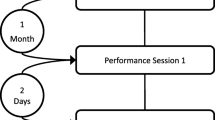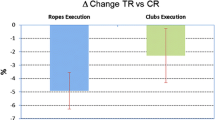Abstract
Music performance anxiety (MPA), or stage fright in music performance, is a serious problem for many musicians, because performance impairment accompanied by MPA can threaten their career. The present study sought to clarify on how a social-evaluative performance situation affects subjective, autonomic, and motor stress responses in pianists. Measurements of subjective state anxiety, heart rate (HR), sweat rate (SR), and electromyographic (EMG) activity of upper extremity muscles were obtained while 18 skilled pianists performed a solo piano piece(s) of their choice under stressful (competition) and non-stressful (rehearsal) conditions. Participants reported greater anxiety in the competition condition, which confirmed the effectiveness of stress manipulation. The HR and SR considerably increased from the rehearsal to competition condition reflecting the activation of sympathetic division of the autonomic nervous system. Furthermore, participants showed higher levels of the EMG magnitude of proximal muscles (biceps brachii and upper trapezius) and the co-contraction of antagonistic muscles in the forearm (extensor digitorum communis and flexor digitorum superficialis) in the competition condition. Although these responses can be interpreted as integral components of an adaptive biological system that creates a state of motor readiness in an unstable or unpredictable environment, they can adversely influence pianists by disrupting their fine motor control on stage and by increasing the risk of playing-related musculoskeletal disorders.





Similar content being viewed by others
References
Abel JL, Larkin KT (1990) Anticipation of performance among musicians: physiological arousal, confidence, and state-anxiety. Psychol Music 18:171–182
Altenmüller E, Jabusch HC (2009) Focal hand dystonia in musicians: phenomenology, etiology, and psychological trigger factors. J Hand Ther 22:144–155
Au AK, Keir PJ (2007) Interfering effects of multitasking on muscle activity in the upper extremity. J Electromyogr Kinesiol 17:578–586
Baumgartner T, Willi M, Jäncke L (2007) Modulation of corticospinal activity by strong emotions evoked by pictures and classical music: a transcranial magnetic stimulation study. NeuroReport 18:261–265
Bernstein N (1967) The co-ordination and regulation of movement. Pergamon Press, New York
Bloemsaat JG, Meulenbroek RGJ, van Galen GP (2005) Differential effects of mental load on proximal and distal arm muscle activity. Exp Brain Res 167:622–634
Boltz MG (1994) Changes in internal tempo and effects on the learning and remembering of event durations. J Exp Psychol Learn Mem Cogn 20:1154–1171
Brotons M (1994) Effects of performing conditions on music performance anxiety and performance quality. J Music Ther 31:63–81
Butler T, Pan H, Tuescher O, Engelien A, Goldstein M, Epstein J, Weisholtz D, Root JC, Protopopescu X, Cunningham-Bussel AC, Chang L, Xie XH, Chen Q, Phelps EA, Ledoux JE, Stern E, Silbersweig DA (2007) Human fear-related motor neurocircuitry. Neuroscience 150:1–7
Cannon WB (1915) Bodily changes in pain, hunger, fear, and rage. Appleton, New York
Cella DF, Perry SW (1986) Reliability and concurrent validity of three visual-analog mood scales. Psychol Rep 59:827–833
Coombes SA, Cauraugh JH, Janelle CM (2006) Emotion and movement: activation of defensive circuitry alters the magnitude of a sustained muscle contraction. Neurosci Lett 396:192–196
Coombes SA, Gamble KM, Cauraugh JH, Janelle CA (2008) Emotional states alter force control during a feedback occluded motor task. Emotion 8:104–113
Cox WJ, Kenardy J (1993) Performance anxiety, social phobia, and setting effects in instrumental music students. J Anxiety Disord 7:49–60
Craske MG, Craig KD (1984) Musical performance anxiety: the three-systems model and self-efficacy theory. Behav Res Ther 22:267–280
Drake C, Palmer C (2000) Skill acquisition in music performance: relations between planning and temporal control. Cognition 74:1–32
Fanselow MS (1994) Neural organization of the defensive behavior system responsible for fear. Psychon Bull Rev 1:429–438
Finsen L, Sogaard K, Jensen C, Borg V, Christensen H (2001) Muscle activity and cardiovascular response during computer-mouse work with and without memory demands. Ergonomics 44:1312–1329
Fishbein M, Middlestadt SE, Ottati V, Straus S, Ellis A (1988) Medical problems among ICSOM musicians: overview of a national survey. Med Probl Perform Art 3:1–8
Fredrikson M, Gunnarsson R (1992) Psychobiology of stage fright: the effect of public performance on neuroendocrine, cardiovascular and subjective reactions. Biol Psychol 33:51–61
Fujii S, Kudo K, Ohtsuki T, Oda S (2009a) Tapping performance and underlying wrist muscle activity of non-drummers, drummers, and the world’s fastest drummer. Neurosci Lett 459:69–73
Fujii S, Kudo K, Shinya M, Ohtsuki T, Oda S (2009b) Wrist muscle activity during rapid unimanual tapping with a drumstick in drummers and non-drummers. Motor Control 13:237–250
Furuya S, Kinoshita H (2008) Organization of the upper limb movement for piano key-depression differs between expert pianists and novice players. Exp Brain Res 185:581–593
Furuya S, Nakahara H, Aoki T, Kinoshita H (2006) Prevalence and causal factors of playing-related musculoskeletal disorders of the upper extremity and trunk among Japanese pianists and piano students. Med Probl Perform Art 21:112–117
Gribble PL, Mullin LI, Cothros N, Mattar A (2003) Role of cocontraction in arm movement accuracy. J Neurophysiol 89:2396–2405
Hajcak G, Molnar C, George MS, Bolger K, Koola J, Nahas Z (2007) Emotion facilitates action: a transcranial magnetic stimulation study of motor cortex excitability during picture viewing. Psychophysiology 44:91–97
Hamann DL, Sobaje M (1983) Anxiety and the college musician: a study of performance conditions and subject variables. Psychol Music 11:37–50
Hanin YL (1978) A study of anxiety in sports. In: Straub WF (ed) Sport psychology: an analysis of athlete behavior. Mouvement, Ithaca, pp 236–249
Hardy L, Parfitt G (1991) A catastrophe model of anxiety and performance. Br J Psychol 82:163–178
Heuer H (2007) Control of the dominant and nondominant hand: exploitation and taming of nonmuscular forces. Exp Brain Res 178:363–373
Kudo K, Ohtsuki T (1998) Functional modification of agonist–antagonist electromyographic activity for rapid movement inhibition. Exp Brain Res 122:23–30
Lang PJ, Bradley MM, Cuthbert BN (1997) Motivated attention: affect, activation, and action. In: Lang PJ, Simons RF, Balaban MT (eds) Attention and orienting: sensory and motivational processes. Erlbaum, Hillsdale, pp 97–135
LeBlanc A, Jin YC, Obert M, Siivola C (1997) Effect of audience on music performance anxiety. J Res Music Educ 45:480–496
Liston C, McEwen BS, Casey BJ (2009) Psychosocial stress reversibly disrupts prefrontal processing and attentional control. Proc Natl Acad Sci USA 106:912–917
Lundberg U (2002) Psychophysiology of work: stress, gender, endocrine response, and work-related upper extremity disorders. Am J Ind Med 41:383–392
Matsumoto N, Yanase-Fujiwara M, Ohtsuki T (2001) Effects of trial importance on the accurate ball-stroking movements. Proceedings of 18th Congress International Society of Biomechanics
Meulenbroek RGJ, van Galen GP, Hulstijn M, Hulstijn W, Bloemsaat G (2005) Muscular co-contraction covaries with task load to control the flow of motion in fine motor tasks. Biol Psychol 68:331–352
Mobbs D, Petrovic P, Marchant JL, Hassabis D, Weiskopf N, Seymour B, Dolan RJ, Frith CD (2007) When fear is near: threat imminence elicits prefrontal-periaqueductal gray shifts in humans. Science 317:1079–1083
Noteboom JT, Fleshner M, Enoka RM (2001) Activation of the arousal response can impair performance on a simple motor task. J Appl Physiol 91:821–831
Osu R, Franklin DW, Kato H, Gomi H, Domen K, Yoshioka T, Kawato M (2002) Short- and long-term changes in joint co-contraction associated with motor learning as revealed from surface EMG. J Neurophysiol 88:991–1004
Papageorgi I, Hallam S, Welch GF (2007) A conceptual framework for understanding musical performance anxiety. Res Stud Music Educ 28:83–107
Pijpers JR, Oudejans RRD, Holsheimer F, Bakker FC (2003) Anxiety-performance relationships in climbing: a process-oriented approach. Psychol Sport Exerc 4:283–304
Sakai N (2002) Hand pain attributed to overuse among professional pianists: a study of 200 cases. Med Probl Perform Art 17:178–180
Schutter D, Hofman D, Van Honk J (2008) Fearful faces selectively increase corticospinal motor tract excitability: a transcranial magnetic stimulation study. Psychophysiology 45:345–348
van Galen GP, Muller M, Meulenbroek RGJ, van Gemmert AWA (2002) Forearm EMG response activity during motor performance in individuals prone to increased stress reactivity. Am J Ind Med 41:406–419
van Gemmert AWA, van Galen GP (1997) Stress, neuromotor noise, and human performance: a theoretical perspective. J Exp Psychol Hum Percept Perform 23:1299–1313
Visser B, de Looze MP, de Graaff MP, van Dieën JH (2004) Effects of precision demands and mental pressure on muscle activation and hand forces in computer mouse tasks. Ergonomics 47:202–217
Wahlström J, Hagberg M, Johnson PW, Svensson J, Rempel D (2002) Influence of time pressure and verbal provocation on physiological and psychological reactions during work with a computer mouse. Eur J Appl Physiol 87:257–263
Wahlström J, Lindegard A, Ahlborg G, Ekman A, Hagberg M (2003) Perceived muscular tension, emotional stress, psychological demands and physical load during VDU work. Int Arch Occup Environ Health 76:584–590
Weinberg RS, Hunt VV (1976) Interrelationships between anxiety, motor performance and electromyography. J Mot Behav 8:219–224
Wilson GD (1997) Performance anxiety. In: Hargreaves DJ, North AC (eds) The social psychology of music. Oxford University Press, Oxford, pp 229–245
Wine J (1971) Test anxiety and direction of attention. Psychol Bull 76:92–104
Yerkes RM, Dodson JD (1908) The relationship of strength of stimulus to rapidity of habit formation. J Comp Neurol Psychol 18:459–482
Yoshie M, Kudo K, Ohtsuki T (2008a) Effects of psychological stress on state anxiety, electromyographic activity, and arpeggio performance in pianists. Med Probl Perform Art 23:120–132
Yoshie M, Shigemasu K, Kudo K, Ohtsuki T (2008b) Multidimensional anxiety and music performance: an exploratory application of the zones of optimal functioning model. In: Buchwald P, Ringeisen T, Eysenck M (eds) Stress and anxiety: application to life span development and health promotion. Logos Verlag, Berlin, pp 163–171
Yoshie M, Shigemasu K, Kudo K, Ohtsuki T (2009) Effects of state anxiety on music performance: relationship between the Revised Competitive State Anxiety Inventory-2 subscales and piano performance. Music Sci 13:55–84
Acknowledgments
This study was supported by the Grant-in-Aid for Scientific Research (#19300216) of Japan Society for the Promotion of Science (JSPS) awarded to T. Ohtsuki and the Grant-in-Aid for JSPS Fellows (#2011133) awarded to M. Yoshie. We express our deep appreciation to five judges of the piano competition, namely Ms. Shoko Sugitani, Dr. Hermann Gottschewski, Ms. Ikuko Endo, Mr. Nobumichi Koyanagi, and Ms. Eriko Kanazawa, and to the staff and contestants of the competition.
Author information
Authors and Affiliations
Corresponding author
Rights and permissions
About this article
Cite this article
Yoshie, M., Kudo, K., Murakoshi, T. et al. Music performance anxiety in skilled pianists: effects of social-evaluative performance situation on subjective, autonomic, and electromyographic reactions. Exp Brain Res 199, 117–126 (2009). https://doi.org/10.1007/s00221-009-1979-y
Received:
Accepted:
Published:
Issue Date:
DOI: https://doi.org/10.1007/s00221-009-1979-y




